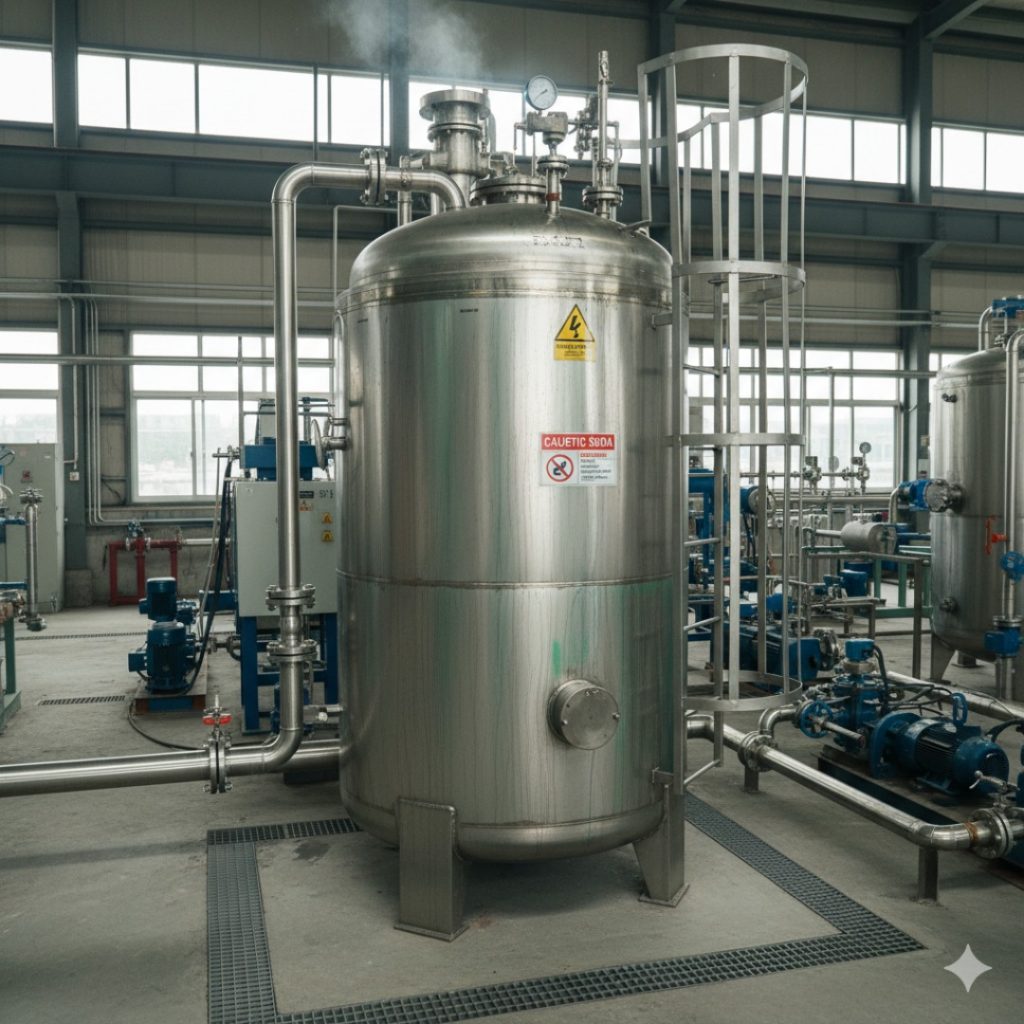Caustic is one of the most aggressive components in the chemical industry. This substance, particularly known as sodium hydroxide (NaOH), is widely used in many fields such as cleaning products, the paper industry, and water treatment. However, storing caustic material safely and for a long time requires serious engineering. This is where stainless caustic tanks come into play.
What is a Stainless Caustic Tank?
A stainless caustic tank is an industrial tank, usually made of AISI 304 or 316 grade stainless steel, specially designed to safely store corrosive chemicals. These tanks offer both chemical resistance and a long lifespan. They differ from standard tanks with their thicker wall structure, high acid-base resistance, and special gasketed fittings.
Areas of Use
Chemical Industry
Caustic is frequently used as a solvent and base in chemical production. Stainless tanks store these substances safely.
Food Sector
Caustic used for cleaning in food production must be stored in tanks with high hygiene standards.
Cleaning Products Manufacturing
Caustic, the raw material for household and industrial cleaning products, poses a risk if not stored under appropriate conditions.
Treatment Plants
Caustic is used in pH balancing processes in wastewater treatment; stainless tanks offer safe solutions in these processes.
Why is Stainless Material Preferred?
Corrosion Resistance
Stainless steel shows high resistance to aggressive substances like caustic.
Long Life and Hygiene
It is hygienic thanks to its non-bacterial structure and can be used for a long time.
Easy Cleaning and Maintenance
It is easy to clean thanks to its smooth inner surface. It is also compatible with CIP systems.
Technical Specifications of Stainless Caustic Tanks
AISI 304 / 316 Grade Difference
While grade 304 is sufficient for general chemicals, grade 316 is ideal for more concentrated and hazardous chemicals.
Jacketed and Heated Structures
Jacketed models are preferred to provide heating or cooling inside the tank.
Mixer Systems
Homogeneity is ensured with mixer systems for high-density liquids.
Level Indicator and Safety Systems
The tank’s contents are safely controlled with level sensors and pressure relief valves.
Caustic Tanks Produced with the Asinoks Difference
Custom Production and Engineering
Asinoks manufactures tanks in custom sizes and technical specifications for every need.
Custom Dimensions and Equipment
Projects are designed specifically for your business’s capacity and needs.
Quality Control Processes
Every product undergoes leakage and durability tests before shipment.
What to Consider When Choosing a Stainless Caustic Tank?
Suitability for Raw Material
The steel grade should be determined according to the caustic substance to be stored.
Capacity Requirement
The correct volume should be chosen according to the business volume and consumption amount.
Operating Environment Conditions
The temperature, humidity, and environmental risks of the area where the tank will be used should be considered.
Certification and Standards
Quality should be assured with documents like CE and ISO.
Compatibility with CIP Cleaning System
Tanks compatible with the CIP (Clean In Place) system allow for internal washing without stopping production. This means both hygiene and time savings.
Storage and Safety Measures
Acid and Base Safety
Special sealing and ventilation systems must be in place for the dangers posed by caustic substances.
Explosion, Leakage, and Overflow Risks
These risks are minimized with sensor-supported control systems.
Energy Efficiency and Environmental Impacts
Contribution of Insulated Structures
Reduces energy costs by preventing heat loss.
Sustainability through Recycling
Stainless steel is fully recyclable and environmentally friendly.
Cost and Return on Investment
Initial Investment and Long-Term Gain
Although the initial cost may seem high, its long life shortens the depreciation period.
Maintenance and Service Advantages
Thanks to Asinoks’s technical service network, it provides the advantage of minimum failure and rapid intervention.
Conclusion
Stainless caustic tanks offer indispensable solutions for the safe and hygienic storage of chemical substances. As Asinoks, with our experience in the sector, we produce safe and durable caustic tanks specific to your business’s needs. Asinoks is always by your side with quality production, technical support, and engineering solutions!
Frequently Asked Questions (FAQ)
- How long can a stainless caustic tank be used?
It can be used for up to 20 years with proper maintenance. - What is the advantage of tanks suitable for the CIP system?
It ensures hygiene without stopping production and saves on labor. - What is the difference between 304 and 316 grade stainless steel?
Grade 316 is more resistant to more aggressive chemicals. - Can the tanks be customized?
Yes, Asinoks offers custom sizes and technical equipment for every need. - How is tank maintenance performed?
It is easily done with periodic cleaning, gasket checks, and level sensor tests.


